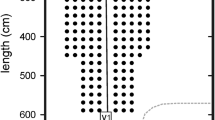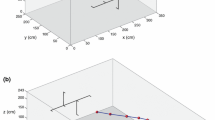Summary
Big brown bats (Eptesicus fuscus) were tested for their ability to detect an electronically simulated target, and to discriminate differences in range to two simulated targets, when receiving either a model of their own sonar emissions or the model reversed in time as the ‘echo’. The theory of matched detection predicts a large decrease in performance if bats use matched filtering, unless they are somehow able to adjust their filter to match the novel, time-reversed signal. The detection thresholds we obtained were much lower than Møhl's (1986), but like him we found no difference in threshold for reversed models (Table 2). This suggests either that bats do not use matched filtering for target detection, or, possibly, that they are able to adapt their filter to a highly unnatural signal in some way as yet unknown.
Unlike detection, range discrimination was much poorer with reversed echoes (Table 3). Threshold increased from about 1 cm range difference with normal model echoes to 18 cm or more with reversed model echoes. This suggests that range determination, which is based on measuring the time of arrival of echoes, does involve matched filtering. Whether such filtering is ‘ideal’ (i.e., equivalent to cross-correlation detection) cannot be decided by our results, but there are some indications that the match between an echo and the presumed internal template (the ‘match’ of matched filtering) must be fairly precise. Also, since performance with phantom targets generated using model echoes was as good as has been found with real targets, the internal template is probably fixed (or only slowly modifiable) rather than re-programmed with each sonar emission. Finally, because synchronization of emission and model echo was not perfect, the apparent distance to targets probably varied by 2 to 4 cm from emission to emission, although both targets would appear to move together thus keeping the range difference constant. This suggests that bats determined range to the targets simultaneously rather than sequentially, as is usually assumed.
Similar content being viewed by others
Abbreviations
- BP :
-
bat-produced echo
- FM :
-
frequency modulated
- M d :
-
detection model echo
- M d :
-
reversed detection model echo
- M rd :
-
range discrimination model echo
- M rd :
-
reversed range discrimination model echo
- rms :
-
root mean square
- SCR :
-
signal-to-clutter ratio
- SNR :
-
signal-to-noise ratio
- SPL :
-
sound pressure level
- XCF :
-
crosscorrelation function
References
Ajrapetjantz AI, Konstantinov AI (1974) Echolocation in nature. 2nd ed. Arlington, Virginia: National Technical Information Service, Report Nos. JPRS-63328–1 and -2
Altes RA (1984) Echolocation as seen from the viewpoint of radar/ sonar theory. In: Varjú D, Schnitzler H-U (eds) Localization and orientation in biology and engineering. Springer, Berlin Heidelberg New York, pp234–244
Altes RA (1985) Detection and classification phenomena of biological systems. In: Urban HG (ed) Adaptive methods in underwater acoustics. D. Reidel, Dordrecht, pp 537–554
Altes RA, Titlebaum EL (1970) Bat signals as optimally Doppler-tolerant waveforms. J Acoust Soc Am 48:1014–1020
Cahlander D (1967) Discussion. In: Busnel R-G (ed) Animal sonar systems: biology and bionics, vol 2. Laboratoire de Physiologie Acoustique, Jouy-en-Josas, France, pp 1052–1081
Escudié B (1980) Signal processing and design related to bat sonar systems. In: Busnel R-G, Fish JF (eds) Animal sonar systems. Plenum Press, New York, pp 715–729
Finney DJ (1971) Probit analysis. Cambridge University Press, London
Gellermann LW (1933) Chance orders of alternating stimuli in visual discrimination experiments. J Genet Psychol 42:206–208
Glaser W (1974) Zur Hypothese des Optimalempfangs bei der Fledermausortung. J Comp Physiol 94:227–248
Green DM, Swets JA (1966) Signal detection theory and psychophysics. Wiley, New York
Henson OW (1965) The activity and function of the middle ear muscles in echolocating bats. J Physiol 180:871–887
Kick SA (1982) Target detection by the echolocating bat, Eptesicus fuscus. J Comp Physiol 145:431–435
Kick SA, Simmons JA (1984) Automatic gain control in the bat's sonar receiver and the neuroethology of echolocation. J Neurosci 4:2725–2737
Kuhl W, Schodder GR, Schröder FK (1954) Condenser transmitters and microphones with solid dielectrics for airborne ultrasonics. Acustica 4:519–532
Masters WM, Moffat AJM, Simmons JA (1985) Sonar tracking of horizontally moving targets by the big brown bat Eptesicus fuscus. Science 228:1331–1333
McCue JJG (1969) Signal processing by the bat Myotis lucifugus. J Aud Res 9:100–107
Møhl B (1986) Detection by a pipistrelle bat of normal and reversed replica of its sonar pulses. Acustica 61:75–82
Pye JD (1986) Sonar signals as clues to system performance. Acustica 61:166–175
Roverud RC, Grinnell AD (1985) Discrimination performance and echolocation signal integration requirements for target detection and distance determination in the CF/FM bat, Noctilio albiventris. J Comp Physiol A 156:447–456
Schnitzler H-U (1984) The performance of bat sonar systems. In: Varjú D, Schnitzler H-U (eds) Localization and orientation in biology and engineering. Springer, Berlin Heidelberg New York, pp 211–224
Schnitzler H-U, Henson OW (1980) Performance of airborne animal sonar systems: I. Microchiroptera. In: Busnel R-G, Fish JF (eds) Animal sonar systems. Plenum Press, New York, pp 109–181
Schnitzler H-U, Menne D, Hackbarth H (1985) Range determination by measuring time delays in echolocating bats. In: Michelsen A (ed) Time resolution in auditory systems. Springer, Berlin Heidelberg New York, pp 180–204
Simmons JA (1971) Echolocation in bats: Signal processing of echoes for target range. Science 171:925–928
Simmons JA (1973) The resolution of target range by echolocating bats. J Acoust Soc Am 54:157–173
Simmons JA (1979) Perception of echo phase information in bat sonar. Science 204:1336–1338
Simmons JA (1980) The processing of sonar echoes by bats. In: Busnel R-G, Fish JF (eds) Animal sonar systems. Plenum Press, New York, pp 695–711
Simmons JA, Grinnell AD (1988) The performance of echolocation: Acoustic images perceived by echolocating bats. In: Nachtigall PE, Moore PWB (eds) Animal sonar: processes and performance. Plenum Press, New York, pp 353–385
Simmons JA, Kick SA, Moffat AJM, Masters WM, Kon D (1988) Clutter interference along the target range axis in the echolocating bat, Eptesicus fuscus. J Acoust Soc Am 84:551–559
Simmons JA, Lavender WA (1976) Representation of target range in the sonar receivers of echolocating bats. J Acoust Soc Am 60 [suppl 1]:S5
Simmons JA, Lavender WA, Lavender BA (1978) Adaptation of echolocation to environmental noise by the bat Eptesicus fuscus. In: Olembo RJ, Castelino JB, Mutere FA (eds) Proceedings of the Fourth International Bat Research Conference, Kenya National Academy for Advancement of Arts and Sciences, Nairobi, Kenya, pp 97–104
Simmons JA, Stein RA (1980) Acoustic imaging in bat sonar: echolocation signals and the evolution of echolocation. J Comp Physiol 135:61–84
Snedecor GW, Cochran WG (1980) Statistical methods, 7th edn. Iowa State University Press, Ames, Iowa
Strother GK (1961) Note on the possible use of ultrasonic pulse compression by bats. J Acoust Soc Am 33:696–697
Suga N, Jen PH-S (1975) Peripheral control of acoustic signals in the auditory system of echolocating bats. J Exp Biol 62:277–311
Surlykke A, Miller LA (1985) The influence of arctiid moth clicks on bat echolocation; jamming or warning? J Comp Physiol A 156:831–843
Troest N, Møhl B (1986) The detection of phantom targets in noise by serotine bats; negative evidence for the coherent receiver. J Comp Physiol A 159:559–567
Urick RJ (1983) Principles of underwater sound (3rd ed). McGraw-Hill, New York
Webster FA, Brazier OG (1965) Experimental studies on target detection, evaluation and interception by echolocating bats. Aerospace Medical Research Laboratories Technical Report AMRL-TR65-172
Wehner R (1987) ‘Matched filters’ — neural models of the external world. J Comp Physiol A 161:511–531
Author information
Authors and Affiliations
Rights and permissions
About this article
Cite this article
Masters, W.M., Jacobs, S.C. Target detection and range resolution by the big brown bat (Eptesicus fuscus) using normal and time-reversed model echoes. J Comp Physiol A 166, 65–73 (1989). https://doi.org/10.1007/BF00190211
Accepted:
Issue Date:
DOI: https://doi.org/10.1007/BF00190211




